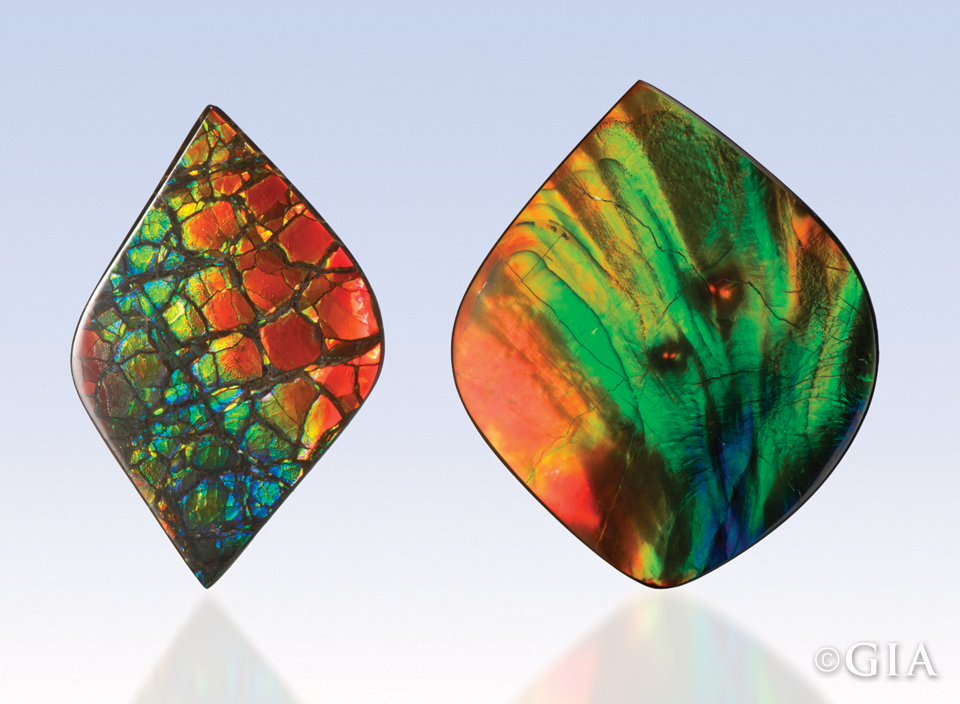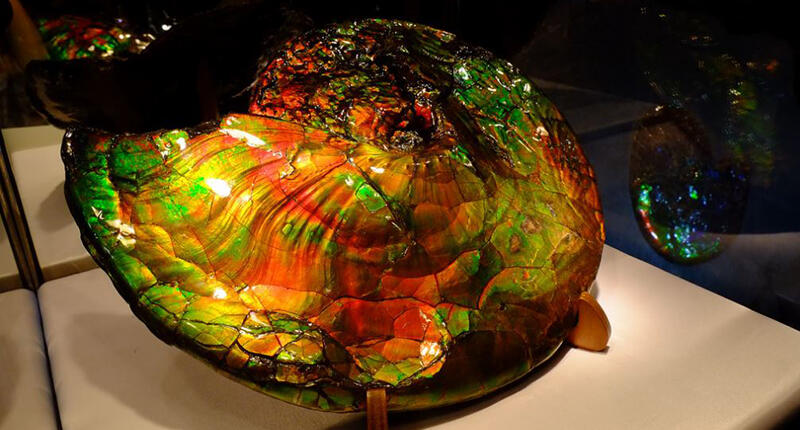
The Wonders of the Earth
As gem fanatics, we know that the world’s most remarkable and beautiful wonders are made by nature rather than man. Breathtaking phenomenons range from beautiful rainbows to the dancing colors of the northern lights and the glory of a peacock feather. What if I told you there is a gemstone that is equally spectacular, displays full chromatic shift in color, and mesmerizes with iridescent properties akin to the rainbows on soap bubbles. In honor of our weeklong event in October celebrating the incredible gems and stones we use to create our pieces, we’d like to introduce you to ammolite.
This iridescent beauty is found exclusively in the Bearpaw region of the Rocky Mountains of North America and is beginning to captivate gem lovers all over the world as it becomes more recognized and admired. Ammolite has a fascinating origin. During the periods of Earth’s history known as the Jurassic and Cretaceous periods, representing a time interval of about 140 million years, schools of squid-like creatures called ammonites hunted in the ocean. With sharp, beak-like jaws and a ring of tentacles, ammonites would be right at home in an alien invasion film.
Ammonites suffered the same fate as the dinosaurs – they became extinct about 66 million years ago, but their story wasn’t over. As countless years passed, the ammonites slowly turned into stunning fossils displaying dramatic play-of-color, a material called ammolite.
It’s All About Light and Color
Just like the material that makes up mother-of-pearl, some rare ammonite specimens have a fossilized outer shell that’s iridescent. Geek alert: the iridescent phenomenon in ammolite arises from the interference of light bouncing off of stacked layers of thin microscopic platelets. As light passes through each microscopic layer of platelets, a fraction of the light is reflected off of each layer, and those numerous reflections interfere with each other to create colored light. That color corresponds to the thickness of the platelet layers, where that layer thickness is about equal to the wavelength of the light observed. So simply put, we’re talking about colors being created by microscopic structures and the way light interacts with those structures.
No one really knows why only ammonites from the Bearpaw formation in Alberta, Canada exhibit such vast and vibrant colors in comparison to ammonites from everywhere else in the world. Many speculate it is due to geological conditions such as minerals coming down from the Rocky Mountains. Many believe that the iron and pyrite rich silt, which flowed into the shallow sea, combined with the high pressure and heat from being buried under a mile or more of ice during the ice ages, is what caused the transformation of the shells in this region. Some go so far as to say red ammolite indicates higher iron concentrations whereas more pyrite concentrations correlate with blues and purples.
While most ammolite displays green and red, blue and violet ammolite occur more rarely and are typically more valuable. Beyond the color, incredible patterns occur, like “dragon skin,” “cobblestone” and “moonglow”, which drastically increase the beauty and individuality of each piece of ammolite.
Ammolite is fragile, about 3.5 on the Mohs hardness scale, so it is typically impregnated with a polymer to stabilize its thin surface layer. Because the layers are thin, ammolite is often assembled into a doublet or triplet. Ammolite is often backed with a material like shale, black onyx, or glass to form a doublet. Sometimes a top layer of quartz or synthetic spinel is added to form a triplet.
Ammolite in the World
Ammolite has become more popular as feng shui has been embraced, especially since popular feng shui master Edward Kui Ming Li began recommending its use. Said to promote the flow of “chi” throughout the body, ammolite’s seven colors are each said to enhance qualities such as wealth, wisdom, health, growth, or energy. Because of this, feng shui practitioners call it the “seven-color prosperity stone. The mystery surrounding its creation has added to the belief that it possesses magical or spiritual properties. It is currently most popular in Asia with many admirers wearing it as jewelry, as well as using larger sample specimens to decorate and protect their homes.
During Rocktober week, October 18th through the 22nd this year, we will have a collection of rare ammolite of the highest quality, brought to you by an expert with a close relationship to the mines in Alberta, Canada. Relationships with mines allow jewelers to offer material that is of the utmost quality, which normally never makes its way into commercial channels. We can’t wait to share this incredible collection and expertise with you!




